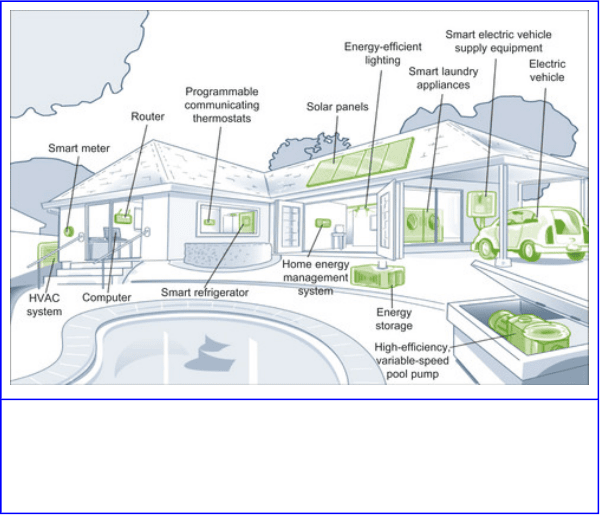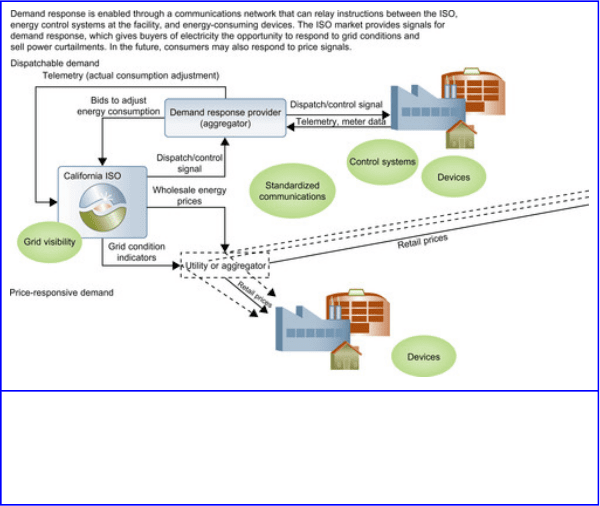Sioshansi F.P. Smart Grid: Integrating Renewable, Distributed & Efficient Energy
Подождите немного. Документ загружается.


energy management system, a modeling system that estimates
the status of the statewide grid, system event analysis, voltage
assessment, automatic economic unit commitment and
dispatch for the real-time and day-ahead markets, a load
forecasting tool, and plant outage scheduler (as shown in
Figure 6.13). Under development is a voltage stability
analysis application that calculates voltages at different
locations on the system to determine those near limits and
sends alerts to grid operators. Integrating this functionality
into the market systems will enable the CAISO to commit
units based on the voltage information.
Figure 6.13
Advanced applications in use or in development at the CAISO.
Source: CAISO Advanced Grid Technology Center
The applications roadmap includes activities to advance
monitoring capabilities, the systems and algorithms to
determine the best use of the grid, including dynamic thermal
line ratings, and automated adaptive generation control that
uses response forecasts of demand, storage, and other system
resources. The roadmap also calls for investigating and
implementing automated decision-making and control
systems. Of course, unforeseen problems may prevent or
delay some technologies coming to market, while technology
advancements may bring about new systems and applications
that are not even contemplated at this time. These
uncertainties contribute to the complexity in upgrading the
361

grid while, at a minimum, maintaining current levels of
reliability.
Enabling Demand Response, Storage, and Distributed
Energy Resources
Among the highest priorities for the CAISO is to identify the
viable smart grid technologies that will aid in understanding
what is happening on the grid and will support active
participation in California's wholesale energy market. The
need to expand demand response, both existing programs and
future price-responsive demand, is driving infrastructure
needs, which include smart devices and control systems that
can collect data, present it to the power users, and then relay
their decisions back to the load-serving utilities or third-party
aggregators (also called curtailment service providers). The
enabling technologies include but are not limited to:
• Building automation systems—the software and hardware
needed to monitor and control the mechanical, heat and
cooling, and lighting systems in buildings that can also
interface with smart grid technologies; and
• Smart homes—similar to smart building technologies,
except designed for the home where devices communicate
with the smart grid to receive and display energy use and
costs, as well as enable energy users to reduce or shift their
use and communicate those decisions to the load-serving
entities. These technologies are also known as home
automation networks (HAN). Figure 6.14 identifies devices
that may be part of the future smart home.
362

Figure 6.14
Devices enabling the future smart home.
Source: CAISO Advanced Grid Technology Center
If the technologies develop as hoped, power users will also be
able to receive real-time prices or indicators of grid
conditions that aid their decision-making processes. For
instance, if the grid is under stress, consumers could elect to
configure devices that automatically respond to these
indicators to shift or curtail use even before wholesale prices
rise or system events occur. This is one reason, along with
price responsiveness, why the CAISO needs to better
understand how consumers use demand response capabilities
so that we can predict responsive behaviors that will affect
forecasts and energy resource unit commitments.
Among the challenges to overcome:
363
• Enhancing current market models, which are based on
operational characteristics of conventional generation
(natural gas, nuclear, hydro), to include models of
distributed generation and the full participation of
demand-side resources, including eventually
price-responsive demand;
• Determining minimum monitoring and telemetry
requirements to enable more cost-effective participation for
many small aggregated demand resources; and
• Maturing standards such as OpenADR
12
to enable
demand response.
12
OpenADR, developed by Lawrence Berkeley National Laboratory, is
a set of rules that specify how building and facility managers can
implement automated demand response in energy management
systems.
Besides conducting the research and analysis to form the
market theories that aid industry understanding of how
demand response and price-responsive demand should work
under real conditions, the CAISO will pursue pilots and
demonstration projects that help prove or disprove
expectations. Figure 6.15 illustrates the data flow resulting
from demand participating in the CAISO market.
364

Figure 6.15
Demand participation data flow in the CAISO market.
Source: CAISO Advanced Grid Technology Center
Smart grid technologies focused on consumers holds the
promise of providing visibility of their real-time use, the
current condition of the grid, and their energy costs. With this
information, consumers can make choices about how to adjust
their energy usage manually, for example by turning down or
off the air conditioner, or automatically by setting thresholds
managed by smart grid technologies. Direct consumer grid
interaction and impact are possible, but only if a host of other
challenges are overcome, including closing the gap between
the wholesale market and retail prices, specification of
communication standards for exchanging this information
between end-users, distribution companies and the ISO, and
improving data confidentiality and network security.
365
The ISO is stepping up its activities to understand and
demonstrate how storage technologies will play a role in the
advancement of renewable integration in conjunction with the
smart grid, including:
• How different types of storage behave (flywheels,
batteries, etc.);
• How they fit into grid operations and can participate in
CAISO energy and ancillary services markets;
• How they can efficiently and effectively provide
regulation service and operating reserves;
• How they can efficiently and effectively shift energy
deliveries from off-peak periods to peak load periods; and
• How they can co-locate with renewable resources to assist
in more efficient use of transmission capacity.
Identifying and creating standards that technologies must
meet become increasingly important and difficult as the
ramping capabilities of renewable resources expand,
increasing the need for capacity to be available that can
follow net demand up and down. As it becomes more feasible
to use different types of demand-side resources during
high-renewable production to maintain reliable grid
conditions and mitigate unfavorable conditions, this should
reduce the need for and the associated costs of building new
dispatchable generation and in some cases, new transmission
lines.
Currently, the CAISO has market mechanisms and products,
such as proxy demand resources that allow aggregators access
to the wholesale market, supporting the increased
participation of storage, demand response, and distributed
366

energy resources and enabling these resources to enjoy
comparable treatment as generating resources. As yet,
however, no model exists that allows these resources to
participate fully. Meanwhile, Western Electricity
Coordinating Council rules are evolving, albeit slowly, to
allow participation in spinning reserve and regulation
markets.
The CAISO is actively participating in wholesale smart grid
standards development efforts led by the National Institute of
Standards and Technology (NIST) through the North
American Energy Standards Board (NAESB) and the ISO/
RTO Council (IRC). The CAISO is also closely involved with
demand response policies being considered at the California
Energy Commission and smart grid proceedings at the
California Public Utilities Commission.
13
13
Information on California Energy Commission programs can be found at
http://www.energy.ca.gov. Information on California Public Utilities
Commission proceedings can be found at http://www.cpuc.ca.gov/puc/.
The enabling demand response, storage, and distributed
energy resources roadmap includes pilots to better understand
technology capabilities, expectations for continued
participation in national standards development efforts, and
developing and piloting approaches for reflecting grid
conditions that can be directly sent to smart grid devices.
Cyber Security
Cyber security becomes a priority concern as additional
technologies connect to grid systems and provide more
real-time data as well as two-way communications. The need
367
exists to assess risks and vulnerabilities all along the
communications chain from data sources to consumers, much
of which is outside CAISO control. There is little doubt that
situations will emerge that require new security controls and
monitoring to ensure that grid monitoring, operations, and
control systems are not compromised. At the same time it is
clear that much of the potential benefit from smart grid will
be due to the significantly increased information available to
the CAISO, participating transmission owners, generators,
and consumers. For this benefit to be realized, the cyber
security rules must not be overly burdensome or so slow to be
developed that they impede the progress of the new
technologies.
A number of national forums are addressing security
concerns. One is the National Institute of Standards and
Technology that recently released NISTIR 7628, Guidelines
for Smart Grid Cyber Security. This is a three-part document
covering smart grid from a high-level functional requirements
standpoint.
Among the challenges associated with cyber security is to
tailor policies for power system monitoring and control
applications, which are complex and industry and application
specific. Implementing, maintaining, monitoring and
improving information security so it is consistent with the
organizational requirements and process are also issues to
address.
The roadmap for cyber security addresses the evaluation and
implementation of secure and standard protocols where
applicable. It also calls for creating centralized security
management and auditing as well as a situational awareness
dashboard.
368
Conclusions
By now the entire electricity industry must recognize that the
traditional ways of performing nearly all core activities are
becoming obsolete, and that the reforms needed for the
twenty-first century will involve unprecedented flexibility to
adapt to change and new ways of thiniking about supply and
demand. Traditionally, operating the grid involved
dispatching large thermal and hydroelectric resources to meet
demand that was virtually entirely exogenous and could
respond to grid conditions only through utility-administered
programs. Transmission planning and generator
interconnection procedures only had to deal with a modest,
predictable rate of annual growth in load and the occasional
addition of new supply resources. Even in regions where new
spot market systems were implemented and have evolved
over the past two decades under independent system operators
and regional transmission organizations, these new markets
were largely designed around traditional assumptions about
the nature of supply and demand.
Today it is obvious that we can no longer operate electric
power systems under the traditional assumptions. Over the
next few years the industry will undergo tremendous changes,
many of which will be the direct result of the technologies
that comprise the smart grid, while others are being driven by
environmental policy mandates that the smart grid will
facilitate. These advances in technology and public policy are
abandoning the traditional nature of electricity supply and
demand, and are empowering consumers to choose their
sources and manage their uses of energy in ways that were
not possible just a few years ago but are now becoming
possible with the emergence of smart grid capabilities.
369
In short, the future electricity industry with the smart grid will
turn the traditional structure on its head. It will be a future
where power flows from the distribution grid to the
transmission grid as well as the other way, and where
demand, rather than just being a passive consumer of energy,
will quickly adjust its behavior in (often automated) response
to price signals, which in turn reflect system conditions.
Further, the distinction between load and generation will
break down as more and more distributed resources such as
solar photovoltaics are installed. These changes will require
more information to be transmitted to energy end-users, and
will also provide an opportunity for the CAISO and
distribution operators to receive significantly more data about
the status of the grid and the consumption and production of
all the supply and demand resources.
For the CAISO, one of the main implications will be the
tremendous increase in data that must be received,
transmitted, processed, understood, and responded to. The
markets will need to accommodate many new types of
entrants, most of whom will be smaller than the existing
market participants. Further, unlike today where the grid is
controlled directly through instructions to a small number of
generation resources which can be counted on to respond, in
the future the control of grid resources will be more indirect,
in the form of adjusting prices and allowing the market
participants to respond as they choose to the new price
signals. This will require new feedback loops that sense how
these indirect control systems are functioning and continually
make adjustments to achieve the desired results.
The potential for efficiently controlling the grid to ensure
power is delivered when and where needed will be greatly
370
